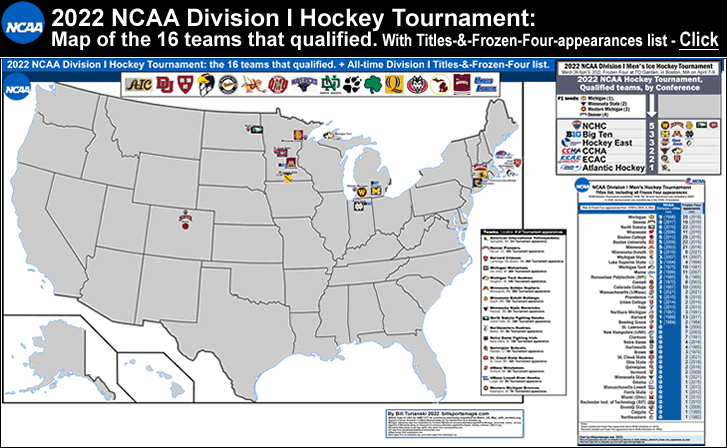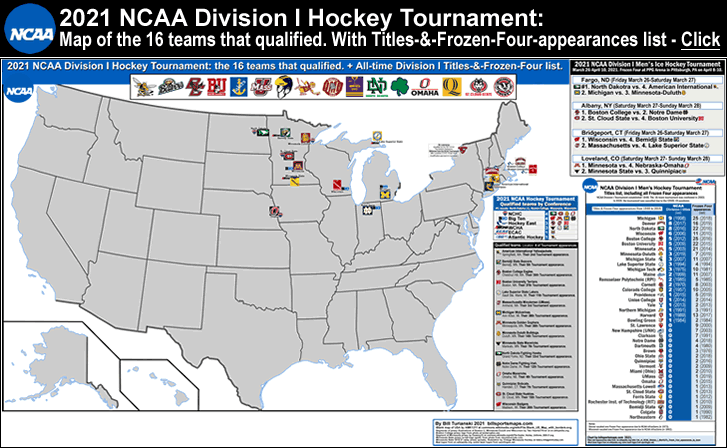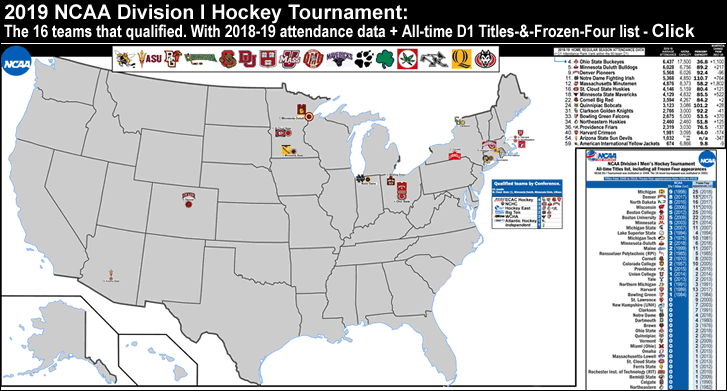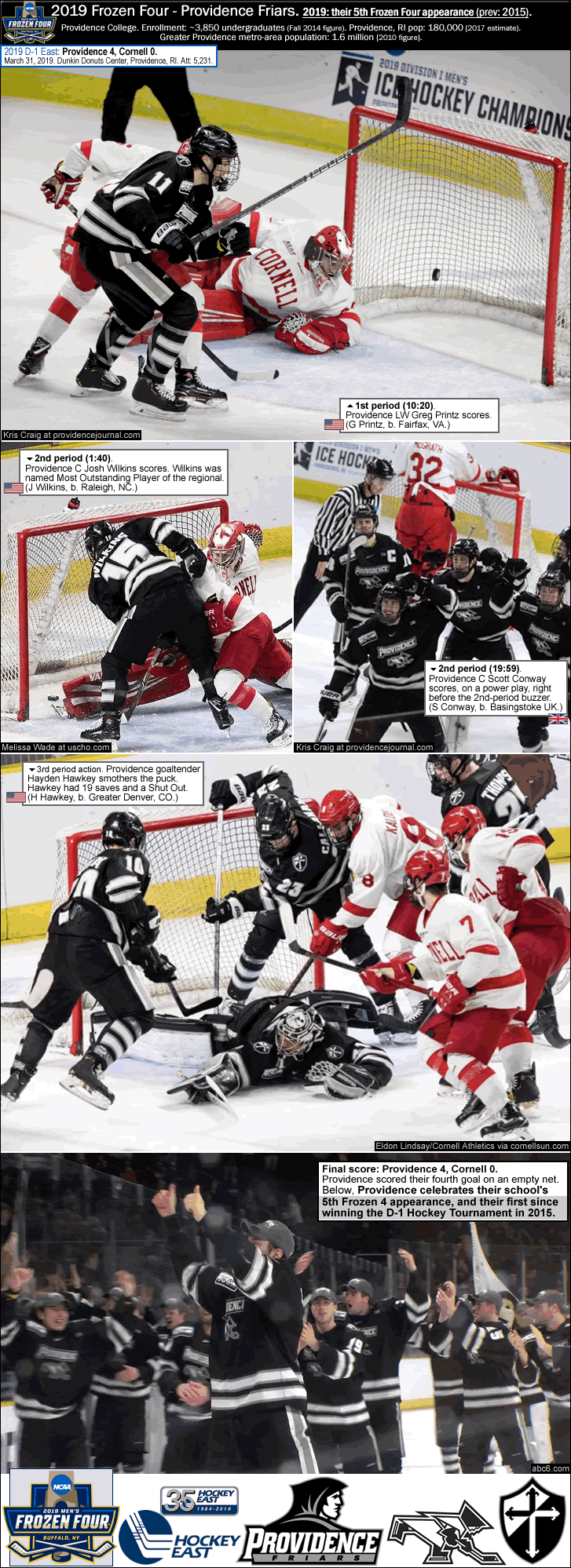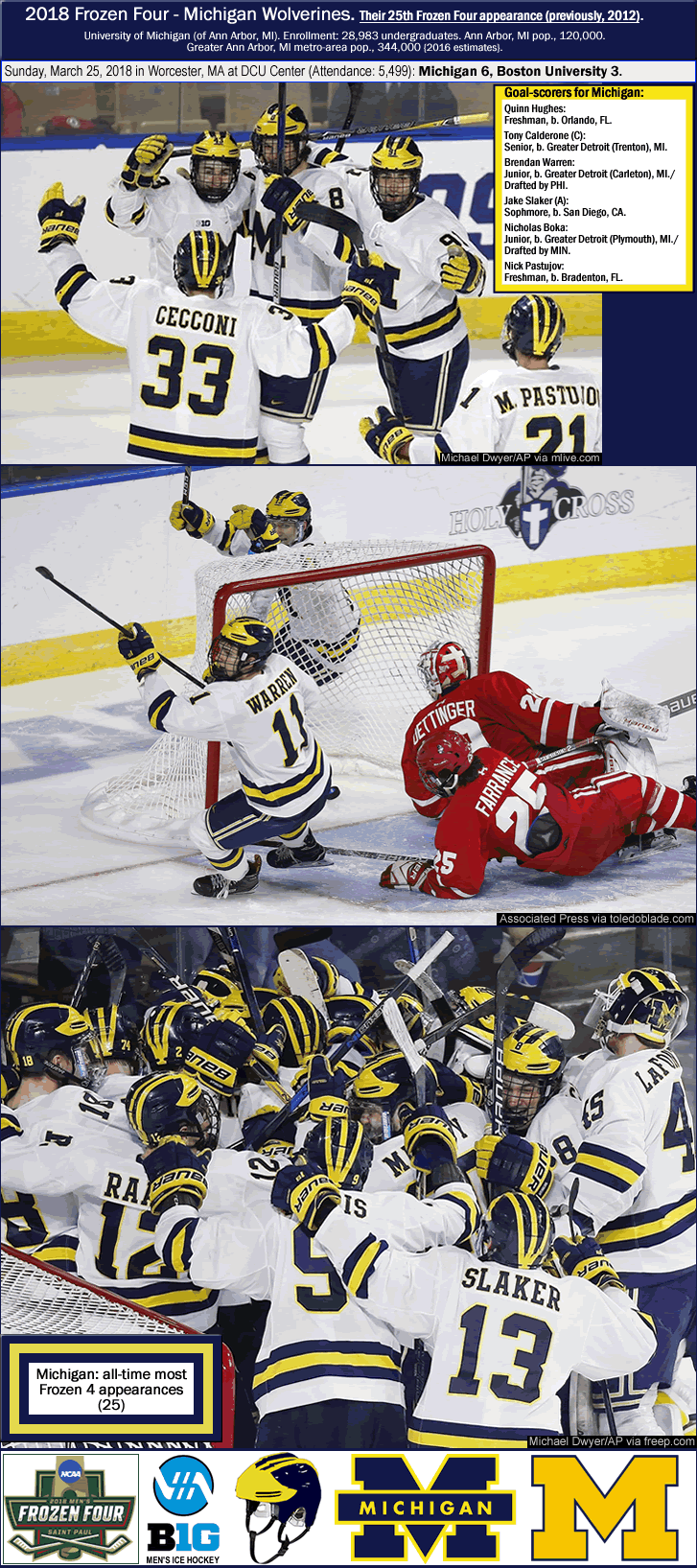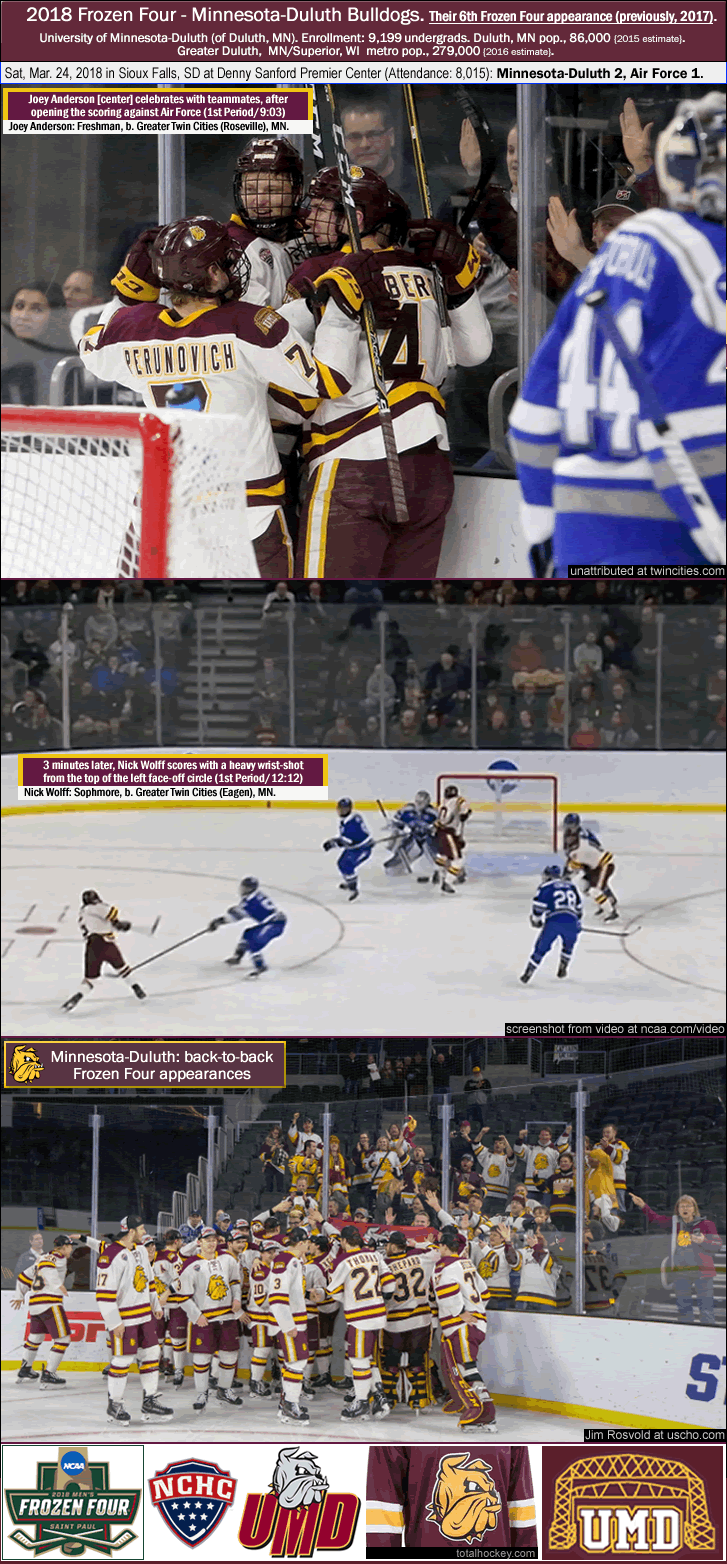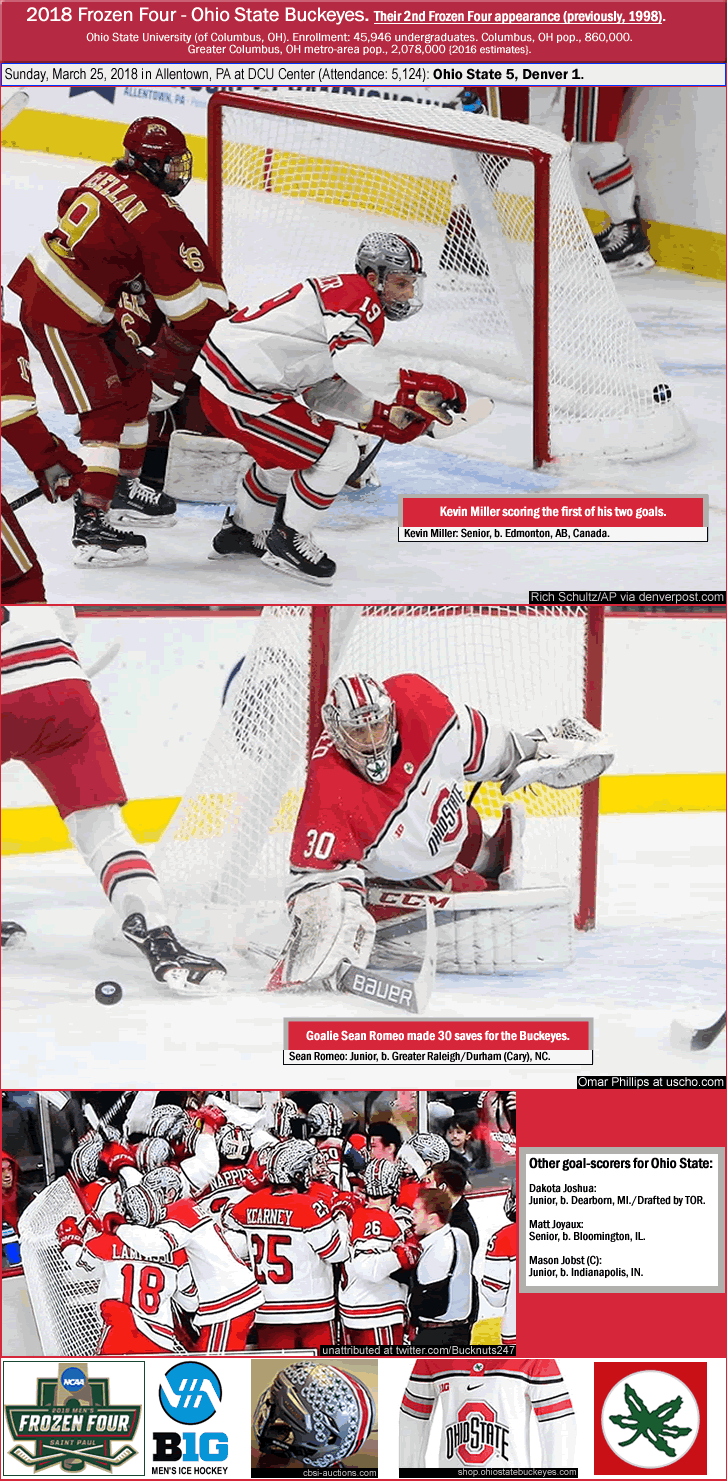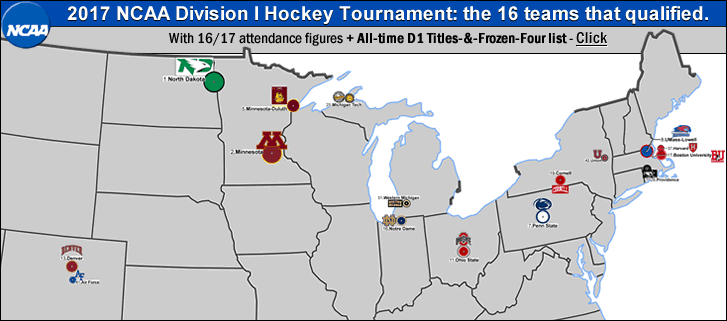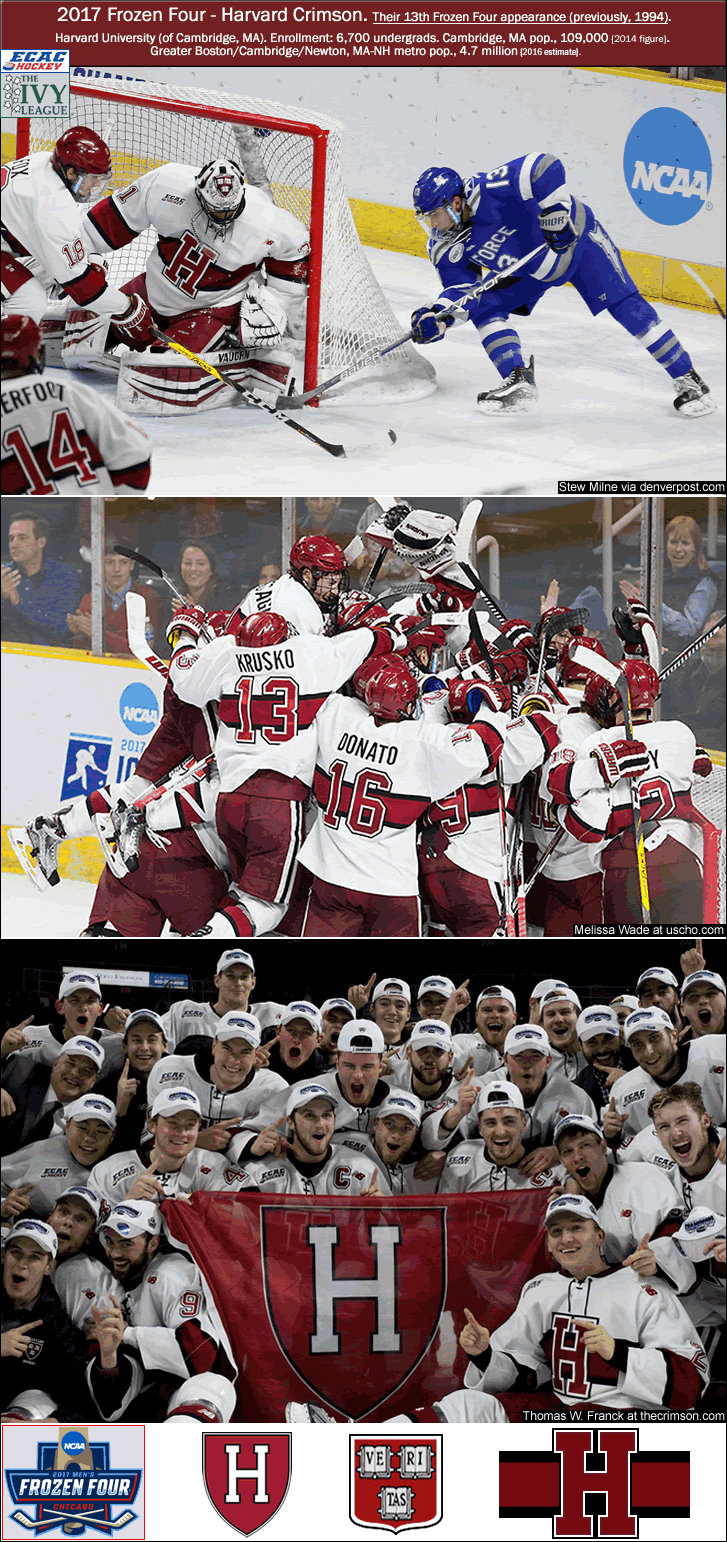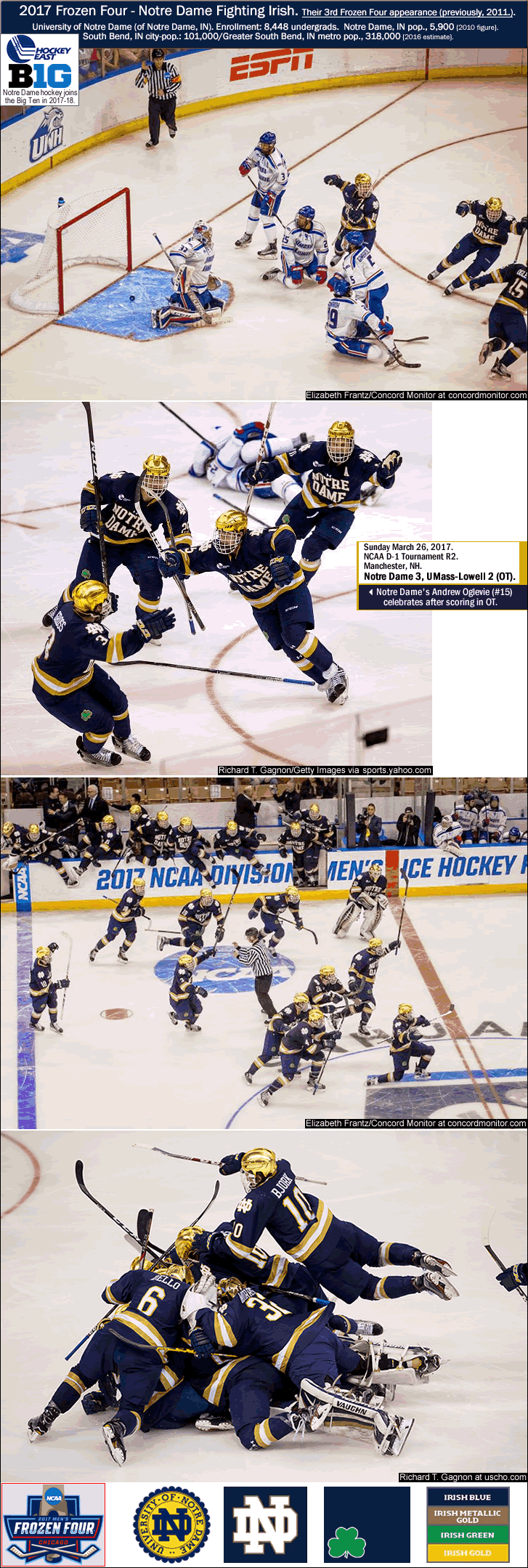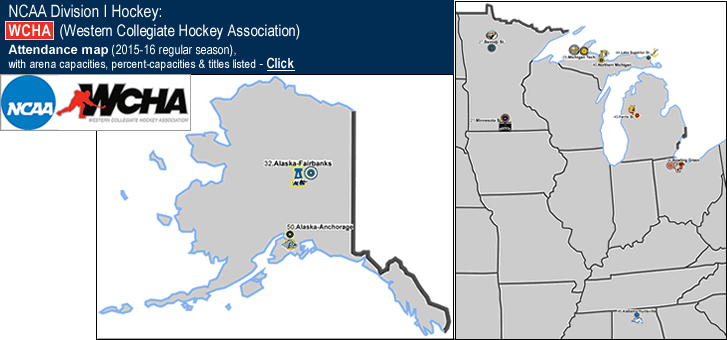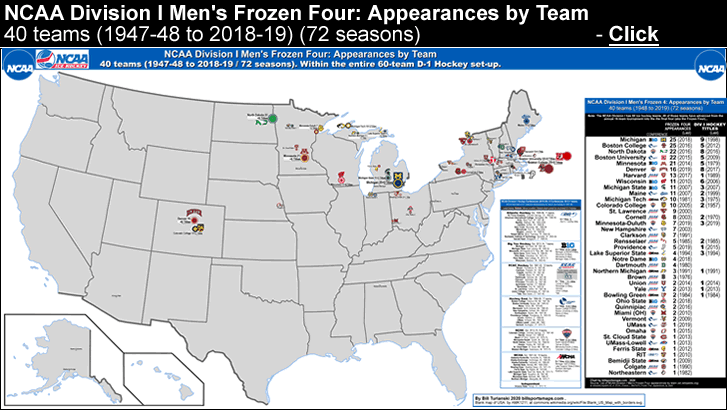
NCAA Division I Hockey Tournament: Map of All-time Frozen Four Appearances (40 teams) (1948 to 2019/72 seasons), with Titles listed
…
…
By Bill Turianski on 9 April 2020. twitter.com/billsportsmaps.
Links…
Source: List of NCAA Division I Men’s Frozen Four appearances by team (en.wikipedia.org).
The NCAA Division I has 60 ice hockey teams. Those 60 D-1 men’s ice hockey teams are split into 6 Conferences (with 1 current Independent team [Arizona State]). Of those 60 D-1 men’s ice hockey teams, 40 teams have advanced into the the final four of the NCAA Division I Men’s Hockey Tournament (aka the Frozen Four). You can read a timeline history of the D-1 hockey tournament, the Frozen Four, and all the D-1 hockey conferences, further below.
The map here shows the 40 teams that have made it to a Frozen Four (72 Frozen Fours, from 1947-48 to 2018-19). The other 20 D-1 hockey teams, which have never advanced to a Frozen Four, are also shown on the map, albeit in smaller text-size and without colors or logos. On the map, each of the 40 teams’ Total-Frozen-Four-Appearances are shown in graphic form by a team-colors-circle that radiates out from the team’s location. The team-colors-circles are sized, with the larger the total Frozen 4 appearances, the larger the team-colors-circle. Alongside each team’s team-color-circle/location-dot/logo is their number of appearances +their Division I men’s hockey titles (21 teams have won a D-1 hockey title). Like the team-color-circles, the team’s logo and text are sized, gradually getting larger with more Frozen 4 appearances; plus I bumped up the text 1-point-size if the team has won a D-1 hockey title.
There are two charts at the right side of the map-page.
∙ The smaller chart closer to the map shows the 60-team NCAA D-1 hockey set-up, by the 6 Conferences: with each school’s hockey-venue-location noted, as well as the season the team joined D-1 hockey (or re-joined D-1 hockey). Total D-1 titles by team, and by conference, are also listed.
The chart at the far right-hand side show these things…
∙ School’s team, with the team’s D-1 hockey conference and their primary logo.
∙ Number of Frozen Four Appearances (with last appearance noted).
∙ Number of D-1 men’s hockey Titles (with last title noted).
…
- {From Wikipedia, here is a map of all 60 D-1 hockey teams, by conference.}
- {From 2016, here is a map of 2015-16 D-1 men’s ice hockey attendance, that I made.} {If you are curious about D-1 men’s ice hockey conferences, go to the right-hand sidebar on my homepage at “NCAA, ice-…”, to see my 2016 posts on the 6 NCAA D-1 men’s ice hockey conferences.}
…
A timeline history of the D-1 hockey tournament, the Frozen Four, and D-1 hockey conferences
As mentioned, there are 60 Division I men’s hockey teams. But actually, 20 of those of those teams represent schools which are otherwise Division II or Division III schools. Here are those 20 schools with D-1 hockey teams, but whose athletics teams are otherwise part of D-II or D-III…
∙ 4 of the 11 teams from Atlantic Hockey: AIC, Bentley, Mercyhurst, RIT.
∙ None of the 7 teams from Big Ten Hockey.
∙ 4 of the 12 teams from ECAC Hockey: Clarkson, Rensselaer, St. Lawrence, Union College.
∙ None of the 11 teams from Hockey East.
∙ 3 of the 8 teams from the NCHC: Colorado College, Minnesota-Duluth, St. Cloud State.
∙ 9 of the 10 teams from the WCHA [ie, all except Bowling Green]: Alabama-Huntsville, Alaska-Anchorage, Alaska-Fairbanks, Bemidji State, Ferris State, Lake Superior State, Michigan Tech, Minnesota State-Mankato, Northern Michigan.
Of these 20 teams from otherwise D-II or D-II schools, seven have won D-1 hockey titles: Minnesota-Duluth (3 titles incl. 2019), Lake Superior State (3 titles), Michigan Tech (3 titles), Rensselaer (2 titles), Colorado College (2 titles), Union College (one title), Northern Michigan (one title).
…
The annual NCAA Division I Men’s Ice Hockey Tournament began in 1947-48, when the NCAA selection committee chose four top D-1 hockey teams to compete in a single-elimination tournament. In the tournament’s first 29 years (1948-76), all the four teams that were selected for the tournament already comprised the Frozen Four. The first ten seasons of the tournament (1948-57) were held at Colorado Springs, CO. Since then, the tournament has been hosted by a different city each year. Michigan won the first D-1 tournament, as well as 6 of the first 10 tournaments; Michigan today has won a record 9 titles (though their last title was won 22 years ago in 1998). Since 2000, the most successful teams are: Boston College, with 4 titles in the last 20 tournaments (most recently in 2012), then Denver and Minnesota-Duluth, both of whom have won 3 titles in the last 20 tournaments, with Denver winning it in 2017, and Minnesota-Duluth winning it in 2018 and 2019.
So, from 1948 to 1976 (29 years), the D-1 hockey tournament comprised just 4 teams. Then, from 1977 to 1987, the tournament comprised 5 or 6 teams. In 1981, the D-1 hockey tournament became an 8-team competition. In 1988, the tournament became a 12-team competition. In 1999, the term Frozen Four was first used by the NCAA. In 2003, the present-day 16-team competition was instituted. The current 16-team tournament involves four city-venues for the Regionals (aka the first round) (in late March), and then another city-venue for the Frozen Four (in early April). Last year, the Frozen Four was held in Buffalo, NY, and the Minnesota-Duluth Bulldogs repeated as champions, defeating the Umass Minutemen 3-0. This season [2019-20], the tournament was cancelled on March 12, due to the coronavirus pandemic.
…
Timeline of D-1 hockey conferences…
Prior to the the first D-1 hockey tournament in 1947-48, there was one “proto-conference”: the Quadrangular League/Pentagonal League. It was initially comprised of four Ivy League schools’ hockey teams: Dartmouth, Harvard, Princeton, and Yale. The Quadrangular League allowed the four to stabilize schedules and to determine the best team of the 4, each season. Army joined in 1946, and it was re-named the Pentagonal League, a name which remained when Army left after the 1947-48 season. Army were replaced by another Ivy League team in 1948: Brown. The grouping continued on until 1954-55. But the Pentagonal League never had the clout to secure an automatic bid into the D-1 hockey tournament (once the tournament started up in 1947-48). This was exacerbated by the fact that the Ivy League never recognized hockey as a D-1 sport. So the Quadrangular League/Pentagonal League is considered an informal organization and is not recognized as an NCAA conference.
1947-48: Back when the D-1 hockey tournament started in 1947-48, D-1 hockey teams were Independent. There were 27 teams in NCAA D-1 hockey in that first season in which there was a trophy to play for {see this, en.wikipedia.org/[1947-48 D-1 hockey/Regular season]}. Of those 27 teams from 1947-48, 20 teams are still in Division I men’s hockey. Those 20 teams are: Army, Boston College, Boston U., Brown, Clarkson, Colgate, Colorado College, Cornell, Dartmouth, Harvard, Michigan, Michigan Tech, Minnesota, New Hampshire, North Dakota, Northeastern, Princeton, St. Lawrence, UMass, Yale.
This Independents-only set-up in D-1 hockey began to gradually change, with the belated creation of D-1 hockey conferences, first in 1950 with the now-defunct Tri-State League, then the following year of 1951 with the creation of what is now known as the WCHA…
1950: the Tri-State League begins play [conference is now defunct]. The first D-1 hockey conference was the Tri-State League (1950-72), a 3-to-6-team conference based in upstate New York, western Massachusetts, and Vermont, which featured small schools like Rensselaer, St. Lawrence, Clarkson, Colgate, Williams (of Massachusetts), and Middlebury College (of Vermont). The Tri State League, despite only having a tiny number of teams (just four teams through most of the 1950s), annually received one of the two eastern bids to the NCAA tournament. The Tri-State League was able to place one team into each D-1 hockey tournament from 1952 to 1960. This accounts for the reason why both St. Lawrence and Clarkson have a considerable amount of Frozen Four appearances (9 and 7 appearances). And meanwhile, after 1951-52, the new MWCHL [WCHA], consisting initially of seven western schools (see next paragraph), was able to earn both western bids for the 4-team tournament each year. This situation, from 1950-51 up until 1959-60, left just one eastern bid available for more than two dozen eastern schools! That was unfair enough as it was, but it got worse in the 1960-61 D-1 season, with 25 Independent teams – all from the Northeast – effectively shut out of the post-season competition…because the 2 western bids for the tournament were sewn up by the WCHA, and the two eastern bids for the tournament went to St. Lawrence and Rensellaer, who were, astoundingly, two of only three teams which comprised the tiny but powerful 1960-61 Tri-State League {1961 D-1 tournament}. This made teams from the New England states feel that the Tri-State League was gaming the system. And, in fact, that is exactly why ECAC Hockey was formed later that year of 1961 (you can see more on that, two paragraphs below).
1951: the WCHA begins play. The second D-1 hockey conference was formed the following season of 1951-52: the still-active Midwest Collegiate Hockey League, or MCHL – which is now called the Western Collegiate Hockey Association, or WCHA. (The MCHL changed its name to the WCHA in 1959.) In 1951-52, there were seven teams that initially comprised the new conference: Colorado College, Denver, Michigan, Michigan State, Michigan Tech, Minnesota, and North Dakota. Instantly, the MCHL had enough clout to secure two of the four D-1 hockey tournament bids. That began in the first season of the MCHL [WCHA] in 1951-52, and that situation of the conference owning half the bids to the D-1 hockey tournament lasted 25 seasons, up to 1976. When the tournament expanded to 5 or 6 teams (1977-80 tournaments), the WCHA still owned 2 bids; when the tournament expanded to 8 teams in 1981, the WCHA got 3 bids (while the ECAC got 4 bids and the relatively new conference the CCHA got 1 bid). In that era (the 1980s), the WCHA and ECAC Hockey were unquestionably the two dominant D-1 hockey conferences.
In the past, the WCHA had a whole lot of successful D-1 hockey programs in it, including Michigan, Denver, North Dakota, Minnesota, Michigan State, Colorado College, and Michigan Tech. Believe it or not, today, those seven teams account for 38 D-1 hockey titles – which is slightly more than half of the 72 D-1 hockey titles! But the profile of the WCHA has diminished considerably. Only one of those seven title-winning teams listed above still remains in the conference, and it is the smallest program of the seven: Michigan Tech, from the isolated Upper Peninsula of Michigan. The WCHA lost all of its big programs during the tumultuous 2010-14 NCAA realignment {see this: NCAA conference realignment/Hockey}. Basically, all the big programs fled from the WCHA, to either the new Big Ten Hockey Conference (Michigan, Michigan State, Minnesota), or to the new NCHC (North Dakota, Denver, Colorado College). Today, the WCHA has, by far, the widest geographic range of D-1 hockey conferences. The 10 teams in the WCHA are spread all the way from Alaska (Alaska-Fairbanks and Alaska-Anchorage) to Alabama (Alabama-Hunstsville) to Minnesota (Bemidji State, Minnesota State at Mankato) to Michigan (all 3 Upper Peninsula D-1 teams [see two sentences below], plus Ferris State) to Ohio (Bowling Green). The conference is frankly too vast to be economically sustainable, and that has influenced the wish of 7 of its 10 members to break off, to re-form a different conference – the CCHA – in 2021-22 (see last paragraph further below). Of the ten teams in the WCHA, four of them have won D-1 hockey titles: Michigan Tech (3 titles), Lake Superior State (3 titles), Northern Michigan, and Bowling Green. That is a total of 8 D-1 hockey titles.
1961: ECAC Hockey begins play. In 1961, the third D-1 hockey conference was formed: the still-active ECAC Hockey. (ECAC stands for Eastern College Athletic Conference.) In 1961-62, ECAC Hockey was formed as a loose association of 28 college hockey teams in the Northeast (New England states plus New York and New Jersey). At the site called College Hockey Historical Archives, it is said…“ECAC Hockey, as it is known today, evolved slowly, starting from a dispute between the New England and New York schools. For the 1961 NCAA Tournament, the selection committee chose St. Lawrence and Rensselaer to represent the East, bypassing the Boston area schools. In the disputes that followed, it was decided to hold an eastern tournament the following season, with the tournament champion given an automatic bid to the NCAA tournament.” {-excerpt from History of ECAC Hockey (augenblick.org).} The 3 New York teams that were getting into the tournament via the small Tri-States League all joined ECAC Hockey as founding members (Clarkson, Rensselaer, St. Lawrence), thus making the Tri-States League superfluous. In ECAC Hockey’s 4th season of 1964-65, the then-29-team ECAC Hockey split into Division I and Division II set-ups, with the creation of ECAC-2 (which is now defunct).
Throughout the 1961-62 to 1975-76 time period (15 seasons), ECAC Hockey and the WCHA were the only two conferences that got bids for the D-1 hockey tournament. That changed when the CCHA finally got an automatic bid in 1976-77 (see 2 paragraphs below). In the 1980-81 to 1983-84 time period, ECAC Hockey was at its most powerful, with control of 4 of the 8 bids to the tournament. But that changed when 5 ECAC Hockey teams left to form Hockey East in 1985 (see 3 paragraphs below).
The ECAC was the only D-1 hockey conference that was unchanged by the 2010-14 realignment. Today, the 12-team ECAC Hockey is a rather unusual college conference, as it includes within it all six of the D-1 Ivy League hockey teams (Brown, Cornell, Dartmouth, Harvard, Princeton, Yale [Penn and Columbia do not field D-1 hockey teams]). ECAC Hockey has teams spread through 6 states in the Northeast and in New England. Six teams are from New York: Clarkson (Potsdam, NY), Colgate (Hamilton, NY), Cornell (Ithaca, NY), Rensselaer (Troy, NY), St. Lawrence (Canton, NY), Union College (Schenectady, NY). Two teams are from Connecticut: Quinnipiac (Hamden, Greater New Haven, CT) and Yale (New Haven, NY). One team is from Massachusetts: Harvard (Cambridge, MA). One team is from Rhode Island: Brown (Providence, RI). One team is from New Hampshire: Dartmouth (Hanover, NH). And one team is from New Jersey: Princeton (Princeton, NJ). Of the 12 teams in ECAC Hockey, five of them have won D-1 hockey titles: Cornell (2 titles), Rensellaer (2 titles), Harvard, Union College, Yale. That is a total of 7 D-1 hockey titles.
1971: the CCHA begins play [the conference is now defunct, but set to be revived in 2021]. The CCHA had less than half-a-dozen members for its first few seasons, including Bowling Green, Ohio State, Lake Superior State, and Western Michigan. The CCHA was initially full of small programs, and did not get an automatic bid into the D-1 hockey tournament until its sixth season, in 1976-77. The teams in the old CCHA were primarily from Michigan and Ohio. In 1981, the CCHA got much more respectable, with the addition of 3 title-winning programs from the state of Michigan: Michigan, Michigan State, and Michigan Tech. But 3 decades later, the D-1 conference realignment of 2010-14 decimated the CCHA. The CCHA disbanded after the 2012-13 season. However, plans are now set to revive the CCHA in 2021 {see last paragraph, further below}.
1984: Hockey East begins play. Hockey East was formed in 1984-85, by five former ECAC teams: Boston College, Boston University, New Hampshire, Northeastern, and Providence. These 5 decided to create their own league, because of scheduling concerns (they feared that the Ivy League teams in the ECAC would form their own conference, but that never came about). It also cannot be denied that the Hockey East set-up has decreased travel costs among its member-teams (seeing as it is a New-England-only-based conference). The 11-team Hockey East conference has teams spread throughout all of the 6 New England states, including 5 teams from Greater Boston. Hockey East teams are: Boston College, Boston University, and Northeastern from Boston, MA; and two more teams from the Greater Boston region: Merrimack (North Andover, MA) and UMass-Lowell (Lowell, MA); UMass (Amherst, MA), Maine (Orono, ME), New Hampshire (Durham, NH), Providence (Providence, RI), UConn (located in Storrs, CT but the hockey team plays 25 miles west in Hartford, CT), and Vermont (Burlington, VT). D-1 hockey title-winning teams from Hockey East are: Boston College (5 titles), Boston University (5 titles), Maine (2 titles), Providence. That is a total of 13 D-1 hockey titles.
1998: Atlantic Hockey begins play (as the MAAC). The 1998-99 season saw the creation of the Metro Atlantic Athletic Conference (MAAC). In June 2003, MAAC Hockey broke off from the rest of the MAAC, and reorganized as Atlantic Hockey. In 2004, the Atlantic Hockey conference was granted an automatic bid to the NCAA Tournament. Atlantic Hockey is comprised of small D-1 programs, 10 of 11 of which are in the Northeast (except for Air Force Academy, who play in Colorado Springs, CO). Here are the 11 teams in the Atlantic League: Air Force; American International College [AIC] (Springfield, MA); Army (West Point, NY); Bentley (Waltham, MA); Canisius (Buffalo, NY); Holy Cross (Worcester, MA); Mercyhurst (Erie, PA); Niagara (Lewiston, NY); Robert Morris (Moon Township, Greater Pittsburgh, PA), Rochester Institute of Technology [RIT] (Henrietta, Greater Rochester, NY), Sacred Heart (located in Fairfield, CT but the hockey team plays 6 miles east in Bridgeport, CT). None of the eleven teams in Atlantic Hockey have won the D-1 hockey title. In fact, in the 16 seasons that Atlantic Hockey has had an automatic bid into the D-1 hockey tournament, only one team in the Atlantic Hockey conference has ever advanced to the Frozen Four…that was RIT, in 2010.
March 2011: the creation of the Big Ten Hockey Conference is announced. The Big Ten Hockey Conference would begin play two-and-a-half years later in 2013-14. That announcement started up the whole, sordid conference realignment in D-1 hockey. The roots of this was the inclusion of Penn State as a D1-hockey team (Penn State debuted as an Independent in D-1 hockey in 2012-13). The shakeup in D-1 hockey conferences occurred in much the same way (and in nearly the same time-period) as the recent realignments in NCAA D-1 football and in NCAA D-1 basketball. After the dust had settled in D-1 hockey, there were 6 conferences instead of 5, and one conference was dissolved – the Central Collegiate Hockey Associaition [CCHA](/see 3 paragraphs above; also see 2 paragraphs below). The Big Ten D-1 Hockey Conference was instituted in the 2013–14 season, combining Penn State with Michigan State, Michigan, and Ohio State from the defunct CCHA, plus Minnesota and Wisconsin from the severely-weakened WCHA. That formed a six-member Big Ten Hockey Conference. Four seasons later, Notre Dame joined Big Ten hockey in 2017-18, to make it a 7-team conference. Here are the locations of the 7 teams in Big Ten Hockey: Michigan (Ann Arbor, MI); Michigan State (East Lansing, MI); Minnesota (Minneapolis, MN); Notre Dame (Notre Dame, Greater West Bend, IN); Ohio State (Columbus, OH); Penn State (State College, PA); Wisconsin (Madison, WI). Four of the seven teams in the Big Ten Hockey Conference have won D-1 hockey titles: Michigan (with a record 9 titles), Wisconsin (6 titles), Minnesota (5 titles), Michigan State (3 titles). That is a total of 23 D-1 hockey titles, which is the most of any D-1 hockey conference, despite its small membership-size.
July 2011: the creation of the NCHC is announced. The NCHC was formed as a reaction to the establishment of the Big Ten Hockey Conference. Basically, the 8 future NCHC teams fled two conferences (the WCHA and the CCHA) which had a majority of small-program-teams. Those 8 teams did this in order to consolidate in a conference with other medium- or large-sized D-1 hockey programs. This, in order to not be overshadowed by the new 800-pound gorilla in the room, the Big Ten Hockey Conference. So four months after Big Ten Hockey was announced, 6 schools from the the WCHA announced their intention of leaving the WCHA, to form a new D-1 hockey conference, to be called the National Collegiate Hockey Conference, or NCHC. Those schools were Colorado College (Colorado Springs, CO); Denver (Denver, CO); Miami (of Ohio) (Oxford, OH); Minnesota-Duluth (Duluth, MN); North [Dakota (Grand Forks, ND); and Omaha (Omaha, NE). A few months later, those six were joined by two more: St. Cloud State (St. Cloud, MN) [also formerly of the WCHA]; and Western Michigan (Kalamazoo, MI) [who would be leaving the soon-to-be-defunct CCHA]. The 8-team NCHC has four teams that have won D-1 hockey titles: North Dakota (with 8 titles), Denver (also with 8 titles), Minnesota-Duluth (3 titles including 2019), Colorado College (2 titles). That is a total of 21 D-1 hockey titles [2nd-most].
February 2020: the revival of the CCHA is announced. (The CCHA originally existed as a D1-hockey conference from 1971 to 2013.) The CCHA will be re-formed, starting in 2021-22. Seven schools, which comprise 70% of the WCHA, announced their intention to start a new D-1 hockey conference, adopting the name of the old CCHA. The 7 teams: Bowling Green (Bowling Green, Greater Toledo, OH); Ferris State (Big Rapids, MI); Lake Superior State (Sault Ste. Marie, Upper Peninsula, MI); and Northern Michigan (Marquette, Upper Peninsula, MI) (all of whom were previously members of the old CCHA when it disbanded in 2013); Michigan Tech (Houghton, Upper Peninsula, MI) (who were in the original CCHA three seasons, from 1981-84), plus Bemidji State (Bemidji, MN) and Minnesota State (Mankato, MN). Now, in their announcement of the conference-shift, there is only talk of “improving geographical alignment” {see this, from USCHO.com}. But what it all really boils down to is this…because of travel costs, those 7 Upper Midwest teams want to break away from three remote teams: the two D-1 hockey teams from Alaska (Alaska-Anchorage and Alaska-Fairbanks), and the D-1 team from northern Alabama (Alabama-Huntsville). As Adam Wodon said at College Hockey News.com…“the three “leftovers” here: Alaska, Alaska-Anchorage and Alabama-Huntsville. I think there’s a pretty clear consensus that everyone feels badly for those programs, and no one wants D-1 to lose teams, but that the other seven schools had to do what they had to do. The path of least resistance for shedding those three schools, was to leave and form a new conference. It was far easier than just kicking them out of the existing WCHA. So now those three will be left on their own, basically nomads. The WCHA could exist in name only, but it wouldn’t matter. With only three teams it wouldn’t get an automatic NCAA bid. Those programs are in trouble, let’s face it.”…{-excerpt from Forget the Name, New-CCHA Will Grapple With Bigger Issues, on Feb. 19 2020, at collegehockeynews.com.}
___
Thanks to all at the following links…
-Thanks to AMK1211 for blank map of USA, ‘File:Blank US Map with borders.svg”>File:Blank US Map with borders.svg‘ (commons.wikimedia.org).
-Thanks to contributors at en.wikipedia.org/List of NCAA Division I Men’s Frozen Four appearances by team; en.wikipedia.org/List of NCAA Division I men’s ice hockey champions.
